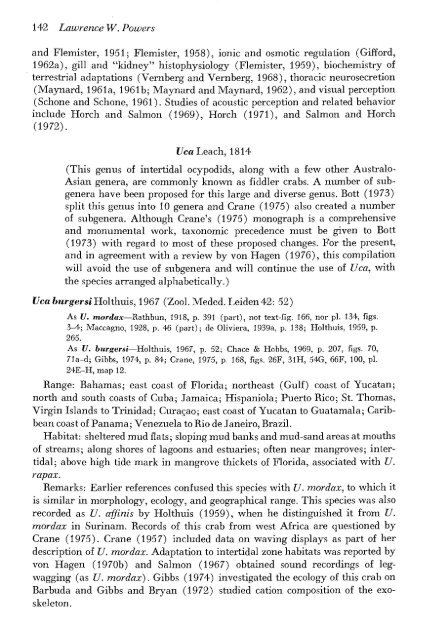You also want an ePaper? Increase the reach of your titles
YUMPU automatically turns print PDFs into web optimized ePapers that Google loves.
142 Lawrence W. Powers<br />
and Flemister, 1951; Flemister, 1958), ionic and osmotic regulation (Gifford,<br />
1962a), gill and "kidney" histophysiology (Flemister, 1959), biochemistry of<br />
terrestrial adaptations (Vernberg and Vernberg, 1968), thoracic neurosecretion<br />
(Maynard, 1961a, 1961b; Maynard and Maynard, 1962), and visual perception<br />
(Schone and Schone, 1961). Studies of acoustic perception and related behavior<br />
include Horch and Salmon (1969), Horch (1971), and Salmon and Horch<br />
(1972).<br />
t/ca Leach, 1814<br />
(This genus of intertidal ocypodids, along with a few other Australo-<br />
Asian genera, are commonly known as fiddler crabs. A number of subgenera<br />
have been proposed for this large and diverse genus. Bott (1973)<br />
split this genus into 10 genera and Crane (1975) also created a number<br />
of subgenera. Although Crane's (1975) monograph is a comprehensive<br />
and monumental work, taxonomic precedence must be given to Bott<br />
(1973) with regard to most of these proposed changes. For the present,<br />
and in agreement with a review by von Hagen (1976), this compilation<br />
will avoid the use of subgenera and will continue the use of IJca, with<br />
the species arranged alphabetically.)<br />
t/ca fcwrgers/Holthuis, 1967 (Zool. Meded. Leiden 42: 52)<br />
As U. inordax—Rathbun, 1918, p. 391 (part), not text-fig. 166, nor pi. 134, figs.<br />
3^; Maccagno, 1928, p. 46 (part); de Oliviera, 1939a, p. 138; Holthuis, 1939, p.<br />
265.<br />
As U. feurgrersi'—Holthuis, 1967, p. 32; Chace & Hcbbs, 1969, p. 207, figs. 70,<br />
71a-d; Gibbs, 1974, p. 84; Crane, 1973, p, 168, figs. 26F, 31H, 34G, 66F, 100, pi.<br />
24E-H, map 12.<br />
Range: Bahamas; east coast of Florida; northeast (Gulf) coast of Yucatan;<br />
north and south coasts of Cuba; Jamaica; Hispaniola; Puerto Rico; St. Thomas,<br />
Virgin Islands to Trinidad; Curasao; east coast of Yucatan to Guatamala; Caribbean<br />
coast of Panama; Venezuela to Rio de Janeiro, Brazil.<br />
Habitat: sheltered mud flats; sloping mud banks and mud-sand areas at mouths<br />
of streams; along shores of lagoons and estuaries; often near mangroves; intertidal;<br />
above high tide mark in mangrove thickets of Florida, associated with V.<br />
rapax.<br />
Remarks: Earlier references confused this species with V. mordax, to which it<br />
is similar in morphology, ecology, and geographical range. This species was also<br />
recorded as V. affinis by Holthuis (1959), when he distinguished it from V.<br />
mordax in Surinam. Records of this crab from west Africa are questioned by<br />
Crane (1975). Crane (1957) included data on waving displays as part of her<br />
description of V. mordax. Adaptation to intertidal zone habitats was reported by<br />
von Hagen (1970b) and Salmon (1967) obtained sound recordings of legwagging<br />
(as V. mordax). Gibbs (1974) investigated the ecology of this crab on<br />
Barbuda and Gibbs and Bryan (1972) studied cation composition of the exoskeleton.

















